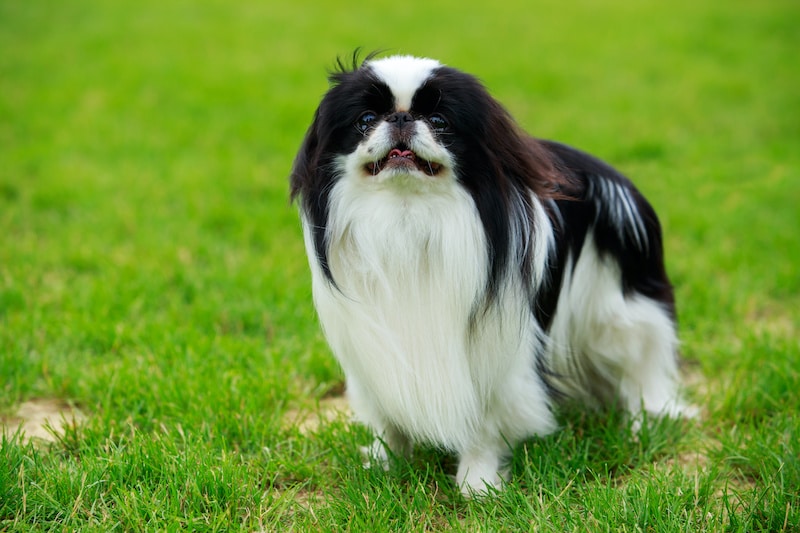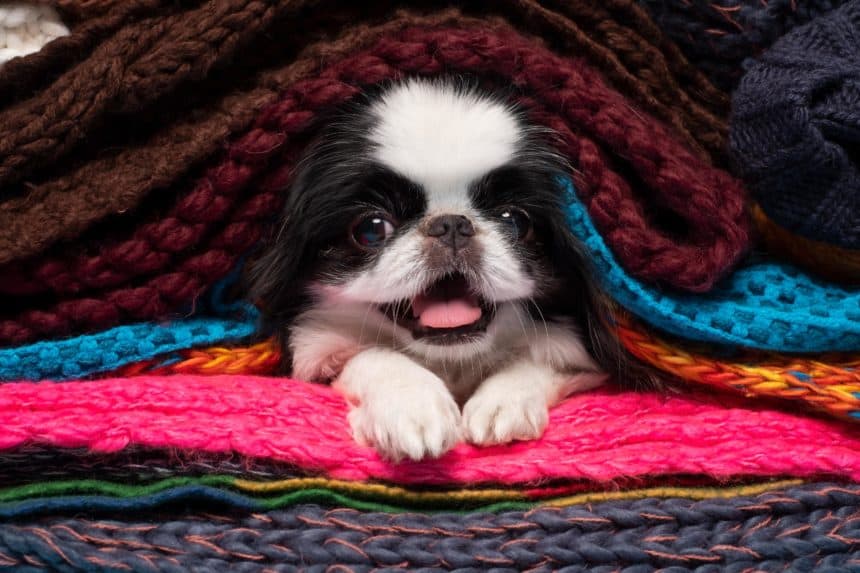
History
Alexandra of Denmark with her Japanese Chin, Punch, painted in 1893. While most people assume that the Japanese Chin’s parent breed originated in China, the way by which the Chin came in Japan is a hotly discussed matter. According to one tale, the dogs were delivered to the Japanese monarchy in AD 732 as presents carried by Kim Jangson (), an ambassador from the kingdom of Silla on the Korean peninsula. Others believe they were given to the Empress of Japan as early as the middle of the sixth century or by the seventh century. Others believe the Chin first came in Japan around the year 1000.
The Japanese Chin was imported to England in 1613. Matthew Calbraith Perry, an American navy commander, purchased one in 1853. Since 1868, they have been lap dogs for upper-class women and are now companion dogs.
Appearance
At the withers, a Japanese Chin typically measures between 20 and 27 cm (8 and 11 in) in height. The typical weight is around 3.2–4.1 kg (7–9 lb), however it may range from as little as 1.4 kg (3 lb) to as much as 6.8 kg (15 lb). Despite the aforementioned preference for lighter pups, neither the American Kennel Club nor the Fédération Cynologique International specify a weight limit for the Chin. It has a striking appearance thanks to its huge, broad, rounded head, wide, black eyes, short, broad nose, feathered ears, and uniformly spaced facial markings.
Typical sartorial attire and hue
Japanese Chin have several characteristics in common with domestic cats. Dogs typically have two distinct layers of hair: an undercoat and an outside coat. A Japanese Chin, on the other hand, wears simply an outer coat. The full growth of an adult coat may take up to two years. Coat colors permitted in competition as of 11 November 2011 are limited to those specified in the breed standard: black and white, red and white (including all shades of sable, lemon, and orange), and tricolor.
In Japanese culture, a dot or line on a dog’s forehead is seen as Buddha’s blessing.
Temperament

It is one of the most cat-like dog breeds in personality, using its paws to clean itself and even purring when it’s happy. They also have an excellent sense of balance, can sneak up on you out of nowhere, and like to nap on high spots, much like cats. The Japanese Chin breed is known for its pleasant demeanor and devotion to its human family. Japanese Chin perform well in both familiar and unfamiliar environments. They have a pleasant disposition and this makes them ideal therapy dogs. Puppies of the Japanese Chin breed that are socialized as young children develop into adults that are more adaptable to new environments and social circumstances.
Although Japanese Chins are generally silent, they will bark to announce the coming of a guest or to bring attention to anything out of the norm since they are protective creatures.
One of the reasons Japanese Chins were originally created was to provide their owners with companionship and fun. Despite their placid demeanor, they are known for a variety of tricks, including the “Chin Spin,” in which they spin rapidly in circles; dancing on their hind legs while pawing the air with their front feet clasped together; and some even “sing,” making a noise that can range from a low trill to a high, almost operatic noise.
Health
The Japanese Chin, like other small breed dogs, is at danger of hypoglycemia if it is less than six months old or weighs less than five pounds. Other common health problems include luxating patellas (slipping kneecaps), cataracts, and early-onset heart murmurs. As a result of the changing seasons, some Japanese Chin suffer from allergies.
The respiratory and vision issues associated with the Japanese Chin are a result of the brachycephalic shape of the face. So, it’s best to stay away from places where the temperature fluctuates wildly, especially the heat. Its large eyes are vulnerable to injury and may sustain corneal scratches or even major ulcerations if rubbed against anything sharp. Mild scratches may be treated with an antibiotic ointment designed for canine eyes, but more severe injuries or ulcers need emergency medical attention.
According to the Japanese Chin Club of America, Chins often live 12–14 years, with some even making it to 15 and beyond.[6] However, a study conducted by the UK Kennel Club found that the median longevity of Chins is only 9.25 years .
Care
The Japanese Chin needs their coat brushed or combed once a week, paying particular attention to the areas around their ears and legs. They may go longer between washes without any harm. These canines seldom, if ever, have an undercoat since they are single-coated and single-hair shedders. Once a year, a Japanese Chin will experience a minor blowout of its coat. They may need to have their anal glands expressed if they don’t get enough fiber in their diet. Japanese Chins are prone to fungal infections because to the accumulation of moisture in the folds of skin around the nose and on the flattened portion of the face. Additionally, the breed needs 16–18 hours of sleep every day and their faces should be washed down with a moist cloth and their folds should be cleansed with a cotton swab regularly.
Many Japanese Chins are very sensitive to or allergic to maize, which highlights the importance of diet in maintaining the health and vitality of this breed. If you want to keep your Japanese Chin healthy and happy, make sure they eat high-quality kibble that doesn’t include any maize.